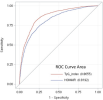Eddy Edson
Well-Known Member
- Relationship to Diabetes
- In remission from Type 2
For those interested, the "TyG Index" is a formula commonly used for estimating insulin resistance. In one version:
ln(fasting BG x fasting trigs)/2
with the quantities expressed in US-style mg/dl. You can easily find calculators on the Web, but here's one which conveniently allows you to enter values in UK-style mmol/l: https://www.optimaldx.com/calculators/tyg-index
along with a discussion and evidence summary: https://www.optimaldx.com/research-...ulation-biomarkers-triglyceride-glucose-index
Anything above about 4.5 is suggestive of insulin resistance.
(This is the most common form of the TyG Index used these days but actually it appears to be the result of an error transcribing the original formula from 2008, which somehow got embedded in the literature. Originally, it was
ln(fasting BG x fasting trigs/2)
With this original formula, the cut-off is around 8. Doesn't matter except for possible confusion if you see numbers quoted which use this original form. More dumbly, you sometimes see papers citing the original formula but reporting results derived from the other one.)
ln(fasting BG x fasting trigs)/2
with the quantities expressed in US-style mg/dl. You can easily find calculators on the Web, but here's one which conveniently allows you to enter values in UK-style mmol/l: https://www.optimaldx.com/calculators/tyg-index
along with a discussion and evidence summary: https://www.optimaldx.com/research-...ulation-biomarkers-triglyceride-glucose-index
Anything above about 4.5 is suggestive of insulin resistance.
(This is the most common form of the TyG Index used these days but actually it appears to be the result of an error transcribing the original formula from 2008, which somehow got embedded in the literature. Originally, it was
ln(fasting BG x fasting trigs/2)
With this original formula, the cut-off is around 8. Doesn't matter except for possible confusion if you see numbers quoted which use this original form. More dumbly, you sometimes see papers citing the original formula but reporting results derived from the other one.)

